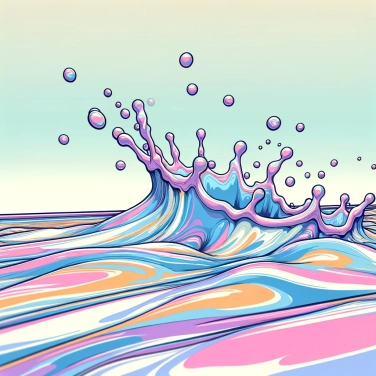Water runs off a waxy surface because the wax creates a hydrophobic barrier that prevents water from infiltrating and forces it to form droplets and slide on the surface.

The water molecule (H₂O) is made up of one oxygen atom and two hydrogen atoms, with a shape somewhat like a "V". This gives the molecule what is called a polarity, meaning it has a part with a small negative charge (on the oxygen side) and another with a small positive charge (on the hydrogen side). Because of this polarity, water molecules tend to attract each other, somewhat like mini magnets. This is why water easily forms droplets instead of spreading out everywhere. This property also helps water molecules interact with or (on the contrary) avoid other substances, depending on whether those substances are polar or not.
Water is a molecule known as polar: this means it has a slightly positive charge on one side and a slightly negative charge on the other. This allows its molecules to attract each other, like tiny magnets. Wax, on the other hand, is made up of predominantly non-polar molecules, which do not have these same magnetic poles. As a result, water molecules have almost no affinity for wax molecules; they do not "stick" together. Therefore, instead of spreading out on the surface, the droplets remain well grouped and flow or slide easily.
Wax is primarily composed of molecules formed from long chains of carbon and hydrogen atoms that are very minimally attracted to water: they are said to be hydrophobic. Water, on the other hand, likes to interact with other polar or charged molecules, which is absolutely not the case with wax. As a result, when you pour water on a waxed surface, the water molecules find no affinity with the wax and prefer to stay grouped together rather than spreading out. It's as if water is actively avoiding contact with the waxy layer. This molecular incompatibility explains why droplets remain compact and easily run off instead of adhering to or wetting the surface.
Surface tension is like an invisible skin on the surface of the water, due to the attractive forces between its molecules. At the waxy surface, these water molecules prefer to attract each other rather than stick to the wax, which causes the formation of rounded water droplets. As the water molecules cluster together rather than spread out, they remain in the form of small, swollen droplets that glide easily. The stronger the attractive force between the water molecules, the rounder and more defined the droplets are. That’s why on a waxy plant leaf or a freshly waxed car, water forms these small beads that roll with the slightest movement.
The wax on the leaves of many plants, such as the lotus, allows them to stay clean by simply sliding water off their surface, carrying away dust and dirt. You find the same idea when you apply a layer of wax to a car's body: water forms beautiful little round droplets that immediately run off without adhering, thus preventing streaks of moisture or mud. Waterproof clothing also uses this principle of hydrophobic coating to allow water to flow off without soaking the fabric and keeping you dry in the rain.
The wax used by certain plants is essential for reducing water evaporation and protecting them from diseases by preventing stagnant water, which is conducive to microbial growth.
Hydrophobia (which literally means 'fear of water') is not only a property related to chemical substances like wax: many modern synthetic fabrics also use this principle to effectively repel moisture.
Some animal species take advantage of natural hydrophobic surfaces to survive. This is particularly true for insects like Gerridae (water striders), which are able to walk on water due to this property.
Lotus leaves have a natural hydrophobic surface similar to wax, allowing them to stay clean by letting water roll off, carrying away impurities. This characteristic has inspired the invention of self-cleaning paints and coatings.
A hydrophilic surface attracts water molecules and allows them to spread out by reducing droplet formation. Conversely, a hydrophobic surface, such as wax, repels water, enhancing the effect of beading droplets.
The use of water-repellent coatings, such as waxes or specific chemical treatments, creates a repellent layer. This method is commonly used to protect surfaces from water, particularly in clothing and automotive applications.
No, there are many hydrophobic substances other than wax, such as oils, silicones, or certain plastics specifically designed to repel water.
The surface tension of water creates a strong cohesion between its molecules, favoring the formation of round droplets rather than their spreading on a hydrophobic surface like wax.
Wax has a hydrophobic nature, meaning that its molecules have no affinity for water molecules. Thus, it prevents water from spreading by forming droplets that glide on the surface instead of soaking into the leaf.

No one has answered this quiz yet, be the first!' :-)
Question 1/5